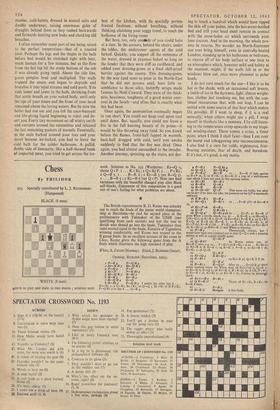Chess
By PHILIDOR
253. Specially contributed by L. J. RICHENBEEG (Hampstead)
BLACK (6 men) WHITE (8 men)
WHITE
to play and mate in two moves ; solution next
week. Solution to No. 252 (Wertheim) : Kt-LQ 5, threatQx13.x...KxKt; 2 QxKtP.x...PxKt; 2 Q-B 5. . . . B-K 6 ; 2 Kt-B 3 (set B-Q 3). z . . . B-B s ; • 2 Kt-B 6 (set Q x P). Note two final variations with the beiutiful changed play after Black self-blocks. Enjoyment of this composition is a good test of one's feeling for what problems are about.
The British representative R. D. Keene was unlucky not to reach the finals of the junior world champion- ship at Barcelona-he tied for second place in the preliminaries with Tuktnakov of the USSR (two qualifying from each section) and lost the loss to decide who should go into the finals. Tukmakov then came second equal in the finals, Kurajica of Yugoslavia winning comfortably, and Keene was second in the B group finals. In an excellent account of the event in Chess, Keene gives the following game from the A finals which illustrates the high standard of play.
White, A. ZWAIG (Norway). Black, J. BLEI1VLAN (Israel).
Opening, SICILIAN (Barcelona, 1965).
13-K 4 P-Q B 4 a Kt-K B 3 Kt,---Q ft 3 3 P-1.4 P x P
4 Kt x P-K Kt 3
g Kt-Q B-Kt 2 6 B-1( 3B 3 Kt 133 3 7 B-Q13 4 0-0 8 13 Kt 3 P-Q R 3 I prefer the older line 8 . . Kt-Kt 5; 9 Q x Kt, Kt x to Q-Q a, Kt XB; R P x Kt, P-Q Kt 3 or else 8 . Q-R 4.
9 P-B 3 AD_Q Kt 4
zo Q-Q 2 Kt-Q R 4 rz P-K g! Kt x B tr . . Kt-K r? fails against 12 B xP ch, K or R x B; t3 Kt-K 6! a trap of a well-known type which I have not seen in this opening before.
12 Kt X Kt Kt-K 13 B-R 6
r4 BxB TB I132 rg 0-0-0! QxP This turns out badly, but what can he do? If he does not take, the'pressure on his Q P is extremely awkward. r6 K R-K r -R 4 z7 Kt--Q g B-Kt a r7 . . . P-K 3??; t13 Kt-B 6
ch.
Ktx P ch Kg-R z
R-Kt
20 Q 4! Q-Kt 4 ch 20 . . QxP; 21 Kt-B 5! gives White a terrific attack, e.g. 21 . . . K R-K I • 22 Kt-Q 7, Q R-Q t; 23 R-R Q x P; 24 Kt-B 61,P-KR 4; 25 Q R x Q; 26 R xR ch Kt-K 1; 27 R x Kt ch, K-Kt 2; 26 Kt x P chi, K-R 3! c211 . P x Kt; 29 R-Kt 8 eh); 29 Kt-Kt g ch, K-Kt 4; 3o R(8 -K I and White is winning. az P-B 4 . . . Thereotically correct, but I would have been very tempted just to play Q-Q 2 with a winning ending as well as a good middle game. 21 . . . QxKt P 22 Q-B 6? . . . As Keene points out, 22 Kt-B 51 wins, e.g. 22 . P x Kt?; 23 R-Kt t or 22 . . . R-Kt
23 Kt-R 6, K 11-B I; 24 R-K 7, P-B 3; 25 Kt-B 7 ch, K-Kt ; 26 QxP.
22 . . QxRP 23 Kt-Q 4 R R-Q z 24 K-Kt r 24 Kt-B 5?, QxK B P ch. 2 • • • Q-R 41 ag4 R-Kt r R-Q 2? After 25. • • Q-Q B 4! there seems nothing better for White than 26 Kt(7)-B 5,Q-B I; 27 Kt-R 6, R-Q 2; 28 Kt-K 6, R x R ch; 29 R x R, P x Kt; • 3o Kt-B 7 ch, K-Kr I; 3t Kt-R 6 ch, drawing by perpets'1 check.
a6 Kt(7)-11 R-Kt z
27 Q R-K. . . Threat 28 Kt x Kt, R x Kt; 29
R-K 8 mate. . '
P-R 3 28 R-K 8! Resigns A fine finish.






























 Previous page
Previous page